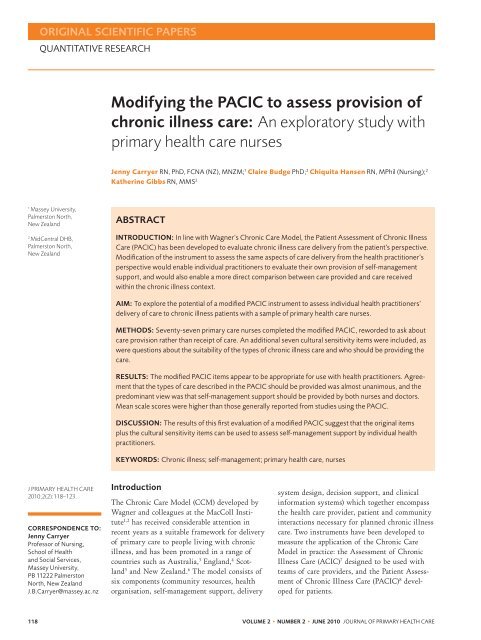entire issue - The Royal New Zealand College of General Practitioners
entire issue - The Royal New Zealand College of General Practitioners
entire issue - The Royal New Zealand College of General Practitioners
You also want an ePaper? Increase the reach of your titles
YUMPU automatically turns print PDFs into web optimized ePapers that Google loves.
ORIGINAL SCIENTIFIC PAPERS<br />
quantitative research<br />
Modifying the PACIC to assess provision <strong>of</strong><br />
chronic illness care: An exploratory study with<br />
primary health care nurses<br />
Jenny Carryer RN, PhD, FCNA (NZ), MNZM; 1 Claire Budge PhD; 2 Chiquita Hansen RN, MPhil (Nursing); 2<br />
Katherine Gibbs RN, MMS 2<br />
1<br />
Massey University,<br />
Palmerston North,<br />
<strong>New</strong> <strong>Zealand</strong><br />
2<br />
MidCentral DHB,<br />
Palmerston North,<br />
<strong>New</strong> <strong>Zealand</strong><br />
ABSTRACT<br />
Introduction: In line with Wagner’s Chronic Care Model, the Patient Assessment <strong>of</strong> Chronic Illness<br />
Care (PACIC) has been developed to evaluate chronic illness care delivery from the patient's perspective.<br />
Modification <strong>of</strong> the instrument to assess the same aspects <strong>of</strong> care delivery from the health practitioner’s<br />
perspective would enable individual practitioners to evaluate their own provision <strong>of</strong> self-management<br />
support, and would also enable a more direct comparison between care provided and care received<br />
within the chronic illness context.<br />
Aim: To explore the potential <strong>of</strong> a modified PACIC instrument to assess individual health practitioners’<br />
delivery <strong>of</strong> care to chronic illness patients with a sample <strong>of</strong> primary health care nurses.<br />
Methods: Seventy-seven primary care nurses completed the modified PACIC, reworded to ask about<br />
care provision rather than receipt <strong>of</strong> care. An additional seven cultural sensitivity items were included, as<br />
were questions about the suitability <strong>of</strong> the types <strong>of</strong> chronic illness care and who should be providing the<br />
care.<br />
Results: <strong>The</strong> modified PACIC items appear to be appropriate for use with health practitioners. Agreement<br />
that the types <strong>of</strong> care described in the PACIC should be provided was almost unanimous, and the<br />
predominant view was that self-management support should be provided by both nurses and doctors.<br />
Mean scale scores were higher than those generally reported from studies using the PACIC.<br />
Discussion: <strong>The</strong> results <strong>of</strong> this first evaluation <strong>of</strong> a modified PACIC suggest that the original items<br />
plus the cultural sensitivity items can be used to assess self-management support by individual health<br />
practitioners.<br />
KEYWORDS: Chronic illness; self-management; primary health care, nurses<br />
J PRIMARY HEALTH CARE<br />
2010;2(2):118–123.<br />
Correspondence to:<br />
Jenny Carryer<br />
Pr<strong>of</strong>essor <strong>of</strong> Nursing,<br />
School <strong>of</strong> Health<br />
and Social Services,<br />
Massey University,<br />
PB 11222 Palmerston<br />
North, <strong>New</strong> <strong>Zealand</strong><br />
J.B.Carryer@massey.ac.nz<br />
Introduction<br />
<strong>The</strong> Chronic Care Model (CCM) developed by<br />
Wagner and colleagues at the MacColl Institute<br />
1,2 has received considerable attention in<br />
recent years as a suitable framework for delivery<br />
<strong>of</strong> primary care to people living with chronic<br />
illness, and has been promoted in a range <strong>of</strong><br />
countries such as Australia, 3 England, 4 Scotland<br />
5 and <strong>New</strong> <strong>Zealand</strong>. 6 <strong>The</strong> model consists <strong>of</strong><br />
six components (community resources, health<br />
organisation, self-management support, delivery<br />
system design, decision support, and clinical<br />
information systems) which together encompass<br />
the health care provider, patient and community<br />
interactions necessary for planned chronic illness<br />
care. Two instruments have been developed to<br />
measure the application <strong>of</strong> the Chronic Care<br />
Model in practice: the Assessment <strong>of</strong> Chronic<br />
Illness Care (ACIC) 7 designed to be used with<br />
teams <strong>of</strong> care providers, and the Patient Assessment<br />
<strong>of</strong> Chronic Illness Care (PACIC) 8 developed<br />
for patients.<br />
118 VOLUME 2 • NUMBER 2 • JUNE 2010 J OURNAL OF PRIMARY HEALTH CARE

















